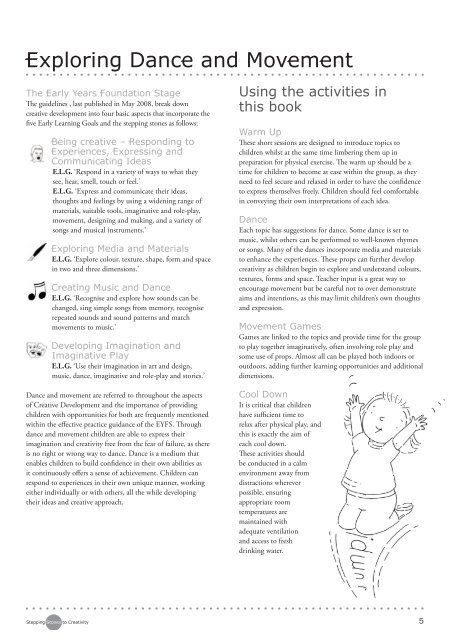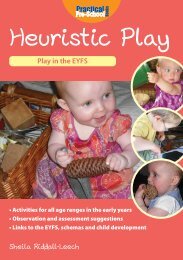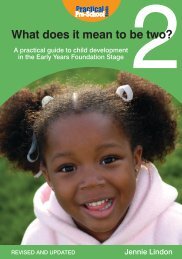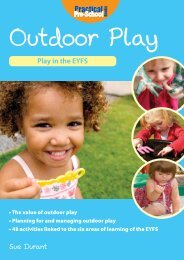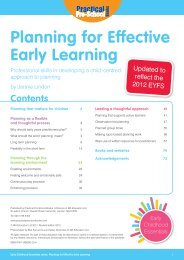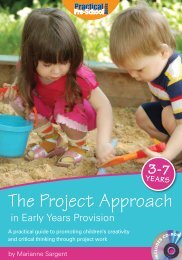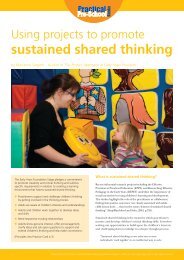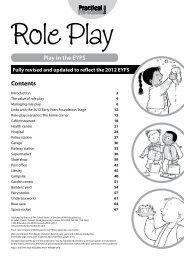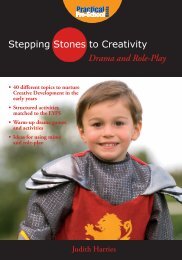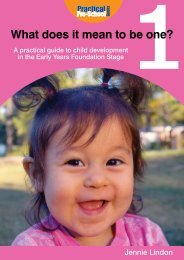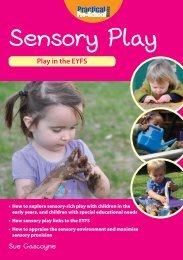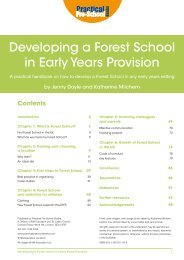SS-Dance Book.indd - Practical Pre-School Books
SS-Dance Book.indd - Practical Pre-School Books
SS-Dance Book.indd - Practical Pre-School Books
- No tags were found...
You also want an ePaper? Increase the reach of your titles
YUMPU automatically turns print PDFs into web optimized ePapers that Google loves.
Exploring <strong>Dance</strong> and Movement<br />
The Early Years Foundation Stage<br />
The guidelines , last published in May 2008, break down<br />
creative development into four basic aspects that incorporate the<br />
five Early Learning Goals and the stepping stones as follows:<br />
Being creative – Responding to<br />
Experiences, Expressing and<br />
Communicating Ideas<br />
E.L.G. ‘Respond in a variety of ways to what they<br />
see, hear, smell, touch or feel.’<br />
E.L.G. ‘Express and communicate their ideas,<br />
thoughts and feelings by using a widening range of<br />
materials, suitable tools, imaginative and role-play,<br />
movement, designing and making, and a variety of<br />
songs and musical instruments.’<br />
Exploring Media and Materials<br />
E.L.G. ‘Explore colour, texture, shape, form and space<br />
in two and three dimensions.’<br />
Creating Music and <strong>Dance</strong><br />
E.L.G. ‘Recognise and explore how sounds can be<br />
changed, sing simple songs from memory, recognise<br />
repeated sounds and sound patterns and match<br />
movements to music.’<br />
Developing Imagination and<br />
Imaginative Play<br />
E.L.G. ‘Use their imagination in art and design,<br />
music, dance, imaginative and role-play and stories.’<br />
<strong>Dance</strong> and movement are referred to throughout the aspects<br />
of Creative Development and the importance of providing<br />
children with opportunities for both are frequently mentioned<br />
within the effective practice guidance of the EYFS. Through<br />
dance and movement children are able to express their<br />
imagination and creativity free from the fear of failure, as there<br />
is no right or wrong way to dance. <strong>Dance</strong> is a medium that<br />
enables children to build confidence in their own abilities as<br />
it continuously offers a sense of achievement. Children can<br />
respond to experiences in their own unique manner, working<br />
either individually or with others, all the while developing<br />
their ideas and creative approach.<br />
Using the activities in<br />
this book<br />
Warm Up<br />
These short sessions are designed to introduce topics to<br />
children whilst at the same time limbering them up in<br />
preparation for physical exercise. The warm up should be a<br />
time for children to become at ease within the group, as they<br />
need to feel secure and relaxed in order to have the confidence<br />
to express themselves freely. Children should feel comfortable<br />
in conveying their own interpretations of each idea.<br />
<strong>Dance</strong><br />
Each topic has suggestions for dance. Some dance is set to<br />
music, whilst others can be performed to well-known rhymes<br />
or songs. Many of the dances incorporate media and materials<br />
to enhance the experiences. These props can further develop<br />
creativity as children begin to explore and understand colours,<br />
textures, forms and space. Teacher input is a great way to<br />
encourage movement but be careful not to over demonstrate<br />
aims and intentions, as this may limit children’s own thoughts<br />
and expression.<br />
Movement Games<br />
Games are linked to the topics and provide time for the group<br />
to play together imaginatively, often involving role play and<br />
some use of props. Almost all can be played both indoors or<br />
outdoors, adding further learning opportunities and additional<br />
dimensions.<br />
Cool Down<br />
It is critical that children<br />
have sufficient time to<br />
relax after physical play, and<br />
this is exactly the aim of<br />
each cool down.<br />
These activities should<br />
be conducted in a calm<br />
environment away from<br />
distractions wherever<br />
possible, ensuring<br />
appropriate room<br />
temperatures are<br />
maintained with<br />
adequate ventilation<br />
and access to fresh<br />
drinking water.<br />
Stepping Stones to Creativity 5


